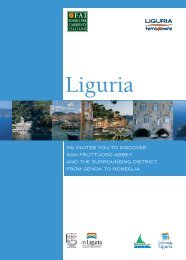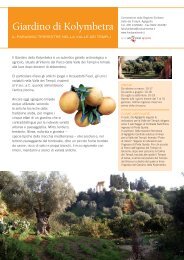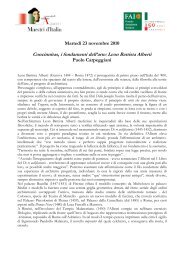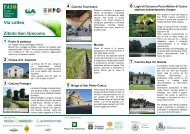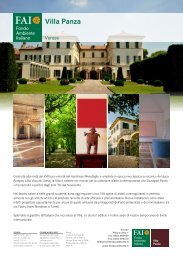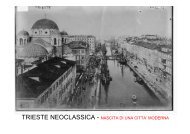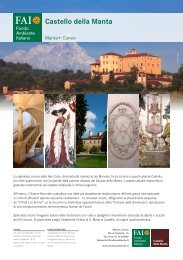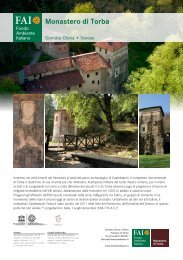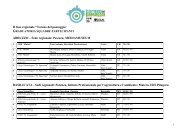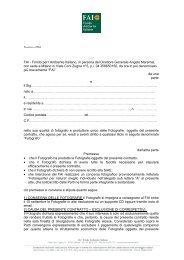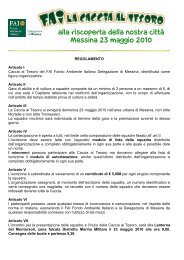Annual Report 2011 - Fai
Annual Report 2011 - Fai
Annual Report 2011 - Fai
Create successful ePaper yourself
Turn your PDF publications into a flip-book with our unique Google optimized e-Paper software.
1. Protecting and enhancing<br />
Restoration<br />
1. Protecting and enhancing<br />
Restoration<br />
© M. Chiesa<br />
To celebrate<br />
together with the<br />
Italians the 150th<br />
anniversary of<br />
Italian Unification,<br />
we have restored<br />
and given back<br />
to the wider<br />
community<br />
three wonderful<br />
properties: the<br />
Negozio Olivetti in<br />
Venice, the Villa<br />
dei Vescovi in<br />
Luvigliano<br />
di Torreglia (Padua)<br />
and the Bosco di<br />
Above: Restoration<br />
work at the Negozio<br />
Olivetti, Venice<br />
THREE PRECIOUS GIFTS GIVEN BACK TO ITALY<br />
In the year that saw the celebrations for the 150th anniversary of Italian Unification,<br />
a significant part of our restoration efforts were focused on those operations geared towards<br />
the three important openings of the year: the Negozio Olivetti in Venice, the Villa dei<br />
Vescovi in Luvigliano di Torreglia (Padua) and the Bosco di San Francesco in Assisi.<br />
These were three completely different projects that allowed us to give back to the community<br />
at large three unique embodiments of Italian history and of the Italian national identity. These<br />
were three “gifts” that we wanted to donate to the Italian people in order to make a tangible<br />
contribution to the recovery of a country that finds itself in the middle of an economic and civil<br />
crisis.<br />
ITALY REDISCOVERS A 20TH-CENTURY ICON<br />
The restoration of the Negozio Olivetti – the first property to be inaugurated during the<br />
year – was carried out by the Assicurazioni Generali insurance group, which owns the<br />
Procuratie Vecchie building in Piazza San Marco in Venice. Having completed the restoration<br />
work over the course of a year, Assicurazioni Generali entrusted us with the running of<br />
this masterpiece created by architect Carlo Scarpa in 1957-58, leading up to the re-opening<br />
of the Showroom on April 20, <strong>2011</strong>.<br />
Our task was to fit out the interiors. It was a very difficult challenge in that the objective<br />
was to give a bona fide icon of 20th-century Italian architecture its original beauty<br />
back, respecting the original vision of the Venetian artist. Assisted by the architect’s son,<br />
Tobia Scarpa, we sited within the Showroom not only the original furnishings but also<br />
a collection of vintage Olivetti typewriters; moreover, we carved out the space for a<br />
bookshop/ticket desk and a staff office. A custom marketing campaign was created for<br />
the opening, with multimedia workstations being put in place to provide historical information<br />
on the architecture of the Showroom and on the entire oeuvre of Carlo Scarpa.<br />
© P. Roggero<br />
THE VILLA DEI VESCOVI, A WONDERFUL EXAMPLE OF GRAND CIVIL<br />
ARCHITECTURE<br />
The second “gift” was the opening of the Villa dei Vescovi, a significant exemplar of<br />
grand Italian civil architecture, immersed in the beautiful scenery of the Euganean<br />
Hills. In this instance, the challenge we faced was to reinstate the Villa’s role as the hub for an<br />
intellectual circle that it had originally acquired from the mid-16th-century onwards, making<br />
the most of that relationship of perfect harmony between manmade architecture<br />
and nature that has always been its exclusive preserve. Having begun in 2007, the long,<br />
laborious restoration process was completed in June <strong>2011</strong>, just prior to the Villa being opened<br />
up to the public. In the months leading up to the inauguration, the works focused mainly on<br />
overhauling the landscaped areas and on the interior design elements, including<br />
the creation of a special technical lighting solution geared towards making the visit all<br />
the more involving. The courtyard space in front of the Villa was restored in such a way as<br />
to retain the original Renaissance design, whereas the outbuilding became the new home<br />
for the shop and the ticket office. To tell the story of the property in the most engaging<br />
way possible, taking in its specific artistic and architectural features and illustrating the main<br />
restoration operations carried out, we decided to use part of the terrace floor of the Villa for the<br />
information rooms, whereas the piano nobile – its Venetian-style flooring now beautifully<br />
restored – plays host to the historical furnishings. Last of all, with a view to transforming<br />
the Villa dei Vescovi into a frame of reference for high-quality tourism throughout the area,<br />
we used the attic floor to create two large guest apartments that are ready to provide a warm<br />
welcome to visitors from around the world.<br />
© G. Majno<br />
2,569<br />
m 2 Venetian-style<br />
and cotto-tile flooring<br />
AT THE VILLA DEI VESCOVI, WE RESTORED<br />
Restoration works at<br />
the Villa dei Vescovi,<br />
Luvigliano di Torreglia<br />
(Padua)<br />
1,390 1,627<br />
m 2 of plasterwork m 2 of frescoes<br />
26 <strong>Annual</strong> <strong>Report</strong> <strong>2011</strong> <strong>Annual</strong> <strong>Report</strong> <strong>2011</strong> 27




